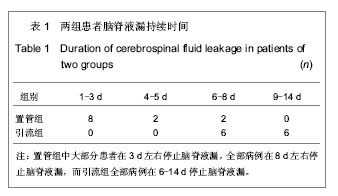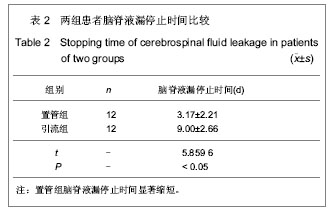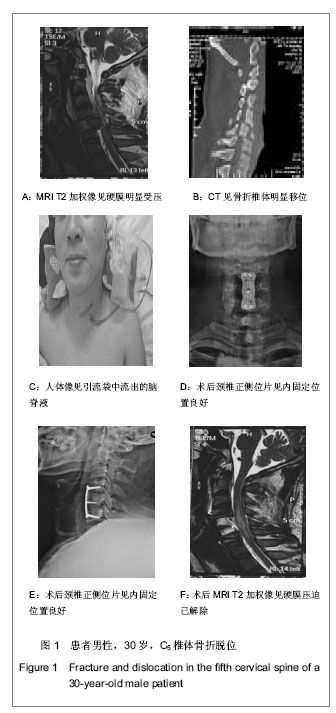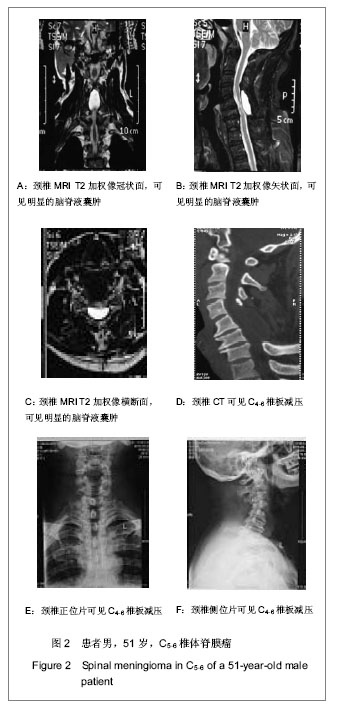| [1] Kalevski SK, Peev NA, Haritonov DG. Incidental Dural Tears in lumbar decompressive surgery: Incidence, causes, treatment, results. Asian J Neurosurg. 2010;5(1):54-59.
[2] 雷涛,王林峰,申勇,等.颈椎严重后纵韧带骨化症前路手术脑脊液漏的预防和处理[J].中华骨科杂志,2012,32(10):962-967.
[3] Schaberg MR, Altman JI, Shapshay SM,et al. Cerebrospinal fluid leak after anterior cervical disc fusion: an unusual cause of dysphagia and neck mass. Laryngoscope. 2007;117(11): 1899-1901.
[4] Sin AH, Caldito G, Smith D,et al. Predictive factors for dural tear and cerebrospinal fluid leakage in patients undergoing lumbar surgery. J Neurosurg Spine. 2006;5(3):224-227.
[5] James HE, Postlethwait R. Primary treatment with temporary subcutaneous peritoneal shunts for postoperative spinal cerebrospinal fluid fistulas. J Neurosurg. 2006;104(5 Suppl): 299-301.
[6] 贺石生,侯铁胜,傅强.脊柱外科中脑脊液漏的防治[J].中国矫形外科杂志,2001,8(3):222-224.
[7] 陈德玉,陈宇,王新伟,等.后纵韧带钩辅助下颈椎后纵韧带骨化物切除减压术[J].中华骨科杂志,2007,27(6):434-437.
[8] 陈雄生,贾连顺,曹师锋,等.颈椎前路手术的并发症[J].中华骨科杂志,2003,23(11):644-649.
[9] 陈宇,陈德玉,袁文,等.颈椎后纵韧带骨化合并硬膜囊骨化的CT影像特点及临床意义[J].脊柱外科杂志,2006,4(5):270-273.
[10] 侯铁胜,傅强,贺石生,等.颈前路减压并发脑脊液漏的处理[J].中华骨科杂志,2003,23(11):650-652.
[11] 孙兆忠,刘涛,房清敏,等.颈椎术后脑脊液漏的处理[J].滨州医学院学报,2005,28(6):423-424.
[12] 张佐伦.脊柱外科手术及并发症学[M].济南:山东科学技术出版社,2002:42-43.
[13] Hannallah D, Lee J, Khan M,et al. Cerebrospinal fluid leaks following cervical spine surgery. J Bone Joint Surg Am. 2008; 90(5):1101-1105.
[14] Fountas KN, Kapsalaki EZ, Nikolakakos LG,et al. Anterior cervical discectomy and fusion associated complications. Spine (Phila Pa 1976). 2007 ;32(21):2310-2317.
[15] 方旭,赵文志,郑连杰.颈椎前路手术的并发症及其处理[J].中国脊柱脊髓杂志,2007,17(8):567-570.
[16] 赵刚,李钦宗,周红星,等.颈椎前路手术并发脑脊液漏的原因及处理方法探讨[J].中国骨与关节损伤杂志,2009,24(11): 1044- 1045.
[17] 余可谊,田野,王以朋,等.颈椎手术后并发脑脊液漏的原因和处理[J].中国脊柱脊髓杂志,2005,15(12):740-743.
[18] Epstein NE, Hollingsworth R. Anterior cervical micro-dural repair of cerebrospinal fluid fistula after surgery for ossification of the posterior longitudinal ligament. Technical note.Surg Neurol. 1999;52(5):511-514.
[19] Fountas KN, Kapsalaki EZ, Johnston KW. Cerebrospinal fluid fistula secondary to dural tear in anterior cervical discectomy and fusion: case report. Spine (Phila Pa 1976). 2005;30(10): E277-280.
[20] Hannallah D, Lee J, Khan M,et al. Cerebrospinal fluid leaks following cervical spine surgery. J Bone Joint Surg Am. 2008; 90(5):1101-1105.
[21] Tian Y, Yu KY, Wang YP,et al. Management of cerebrospinal fluid leakage following cervical spine surgery. Chin Med Sci J. 2008;23(2):121-125.
[22] 邵立民,陈焕林.腰椎间盘摘除术硬脊膜损伤的防治对策[J].中国骨伤,2007,20(10):700-701.
[23] Chang HS, Kondo S, Mizuno J,et al. Airway obstruction caused by cerebrospinal fluid leakage after anterior cervical spine surgery. A report of two cases.J Bone Joint Surg Am. 2004;86-A(2):370-372.
[24] Kitchel SH, Eismont FJ, Green BA. Closed subarachnoid drainage for management of cerebrospinal fluid leakage after an operation on the spine. J Bone Joint Surg Am. 1989;71(7): 984-987.
[25] 刘栋,沈忆新,郝剑.椎滑脱内固定术并发症的分析与防治[J].中国骨伤,2008,21(4):253-255.
[26] 慈元,李正维,敖强,等.脂肪颗粒与生物蛋白胶联合应用预防硬膜外粘连的实验研究[J].中国脊柱脊髓杂志,2004,14(8):486-489.
[27] 张阳德,向忠,彭健.硬脊膜损伤分度及预防脑脊液漏的临床研究[J].中国现代医学杂志,2007,17(11):1349-1351.
[28] 王宵光,王淙清.下腰椎后路手术并发脑脊液漏的处理[J].颈腰痛杂志,2006,27(5):347-349.
[29] 王平均,倪凤民,杨小龙,等.腰椎间盘突出症术后并发脑脊液漏的原因和治疗策略[J].颈腰痛杂志,2010,31(4):288-289.
[30] 麻妙群.全臂丛神经根性撕脱伤脑脊液漏的护理[J].中国骨伤, 1998,11(3):67.
[31] 孙垂国,陈仲强,齐强,等.胸椎黄韧带骨化症手术并发硬脊膜损伤或脑脊液漏的原因分析及防治[J].中国脊柱脊髓杂志,2003, 13(12):724-727.
[32] 王德利,阮狄克,邱迪,等.脊柱手术并发隐性脑脊液漏的诊断和治疗[J].中国矫形外科杂志,2004,12(3):310-311.
[33] 唐六一,胡虹,张耀明.脊柱手术并发脑脊液漏的原因和治疗方式[J].实用医院临床杂志,2008,5(5):67-68.
[34] 韦敏克,梁斌.脊柱手术硬脊膜损伤及脑脊液漏的诊治进展[J].中国矫形外科杂志,2008,16(10):756-758.
[35] 马泽民,吕国华,王冰,等.脊柱手术后合并脑脊液漏52例分析与处理[J].中国现代医学杂志,2003,13(14):133-136.
[36] 田永刚,江毅.脊柱手术后脑脊液漏的治疗进展[J].临床医学, 2010, 30(10):116-118.
[37] 向可述,蔡洪,王进,等.椎间盘髓核摘除术后脑脊液漏36例[J].中国骨与关节损伤杂志,2005,20(2):118-119.
[38] 张超远,宋应超,付鹏军,等.脊柱手术后并发脑脊液漏的治疗[J].中国脊柱脊髓杂志,2007,17(8):610,614.
[39] 程增银,马文海,崔建平,等.延长引流时间并间断夹闭引流管治疗脊柱术后脑脊液漏的疗效观察[J].中国脊柱脊髓杂志,2010, 20(12):985-987.
[40] 全必春,王文军,姚女兆,等.脊柱术后脑脊液漏并椎管内感染20例分析[J].医学临床研究,2005,22(4):534-535.
[41] Sciubba DM, Kretzer RM, Wang PP. Acute intracranial subdural hematoma following a lumbar CSF leak caused by spine surgery.Spine (Phila Pa 1976). 2005;30(24):E730-732.
[42] Jankowitz BT, Atteberry DS, Gerszten PC,et al. Effect of fibrin glue on the prevention of persistent cerebral spinal fluid leakage after incidental durotomy during lumbar spinal surgery. Eur Spine J. 2009;18(8):1169-1174.
[43] Weng YJ, Cheng CC, Li YY,et al. Management of giant pseudomeningoceles after spinal surgery. BMC Musculoskelet Disord. 2010;11:53.
[44] Tosun B, Ilbay K, Kim MS,et al. Management of Persistent Cerebrospinal Fluid Leakage Following Thoraco-lumbar Surgery. Asian Spine J. 2012;6(3):157-162.
[45] 于凤宾,陈德玉,王新伟,等. 颈前路后纵韧带骨化切除术并发脑脊液漏的处理及疗效分析[J].中国脊柱脊髓杂志,2012,22(10): 889-893.
[46] 贾连顺.颈椎手术并发脑脊液漏的早期诊断与处理[J].中国脊柱脊髓杂志,2010,20(3):253-254.
[47] 程增银,马文海,崔建平,等.延长引流时间并间断夹闭引流管治疗脊柱术后脑脊液漏的疗效观察[J].中国脊柱脊髓杂志,2010,20 (12): 985-987. |



